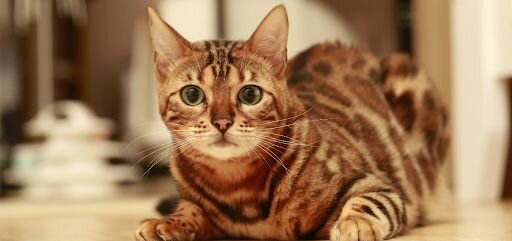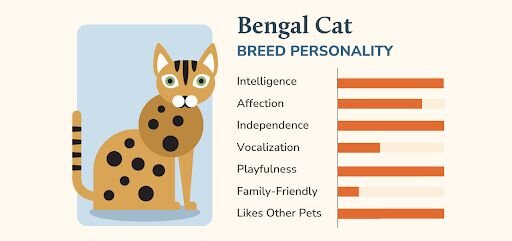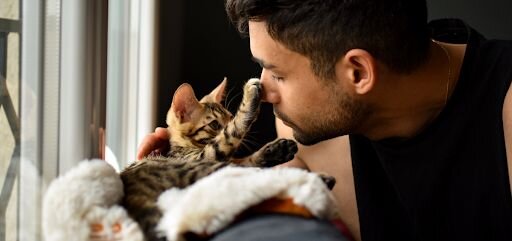Bengal Cat: Breed Profile, Personality Traits & Care Guide
Bengal cats are eye-catching and exotic athletes that make you feel like you have your very own leopard. These intelligent cats are growing in popularity because of their playful nature and gorgeous looks.
Here's what we'll cover in our breed guide:
About the Bengal Cat
Aliases: Felis catus × Prionailurus bengalensis bengalensis
Origin
The Bengal cat traces its heritage back to 1963 when Jean S. Mill bred a domestic cat with the Asian Leopard Cat, a small, spotted, non-domestic Asian cat.
Purpose
Bengals were the first attempt to create a hybrid offspring that was a domestic cat with the gorgeous, spotted look of Ocelots, Jaguars, and Leopards. Today, they are the only domestic cat breed with rosette-like markings on their body.
Did you know..?
Fun Fact About Bengal Cats: Unlike most domestic cats, many Bengal cats love water due to their Asian Leopard heritage. Many pet parents report that their Bengal cat will jump into the shower with them!
Physical Appearance
Bengal cats have gorgeous leopard-like coats that are plush and eye-catching. Their rosette-like markings make them stand out among domestic cats. Their broad noses and prominent whisker pads complete their wild look.

Size
The first thing you’ll notice about a Bengal, besides its stunning coat, is that they are typically larger than your average cat. These beautiful cats also move like gymnasts and exhibit grace and precision when they move, leap, or pounce. Their thick tails steady them, giving them incredible balance.
Average Male Bengal Weight: 10 - 15 pounds
Average Female Bengal Weight: 8 - 10 pounds
*Remember that these weights are estimates. Every cat is unique and will have a different ideal weight based on their health, age, size, etc.
Coat
Length:
Bengal cats have short, plush coats.
Common Colors:
- Silver chocolate
- Brown
- Sable
- Lavender
- Snow
- Silver
Rare Bengal Colors:
- Blue
- Cream
- Black
- Charcoal
Patterns:
- Spotted/Rosetted
- Marble
Types of Bengal Cats
- Bengal Brown Spotted
- Bengal Snow Leopard
- Bengal Marble
- Charcoal Bengal Cat
Bengal Lifespan
Bengal cats have an average life expectancy of 12 to 16 years.1 The average cat lifespan is 14 years.
Genetic Predispositions
The Bengal is a healthy breed, but they are prone to certain genetic conditions. Bengal cats may be more predisposed to hip dysplasia, hypertrophic cardiomyopathy, and progressive retinal atrophy.2
Hip dysplasia occurs when the hip joints develop abnormally. Certain breeds, like the Bengal, may be predisposed to this condition because of their larger build. Cats with hip dysplasia may limp, avoid physical activity, or express pain if their hips are touched. Overweight cats are at an increased risk of developing hip dysplasia or worsening existing symptoms.
Looking to save on vet bills? See which pet insurance is right for you.
Instant results. 1M+ pet parents served.
⭐⭐⭐⭐⭐ 4.9 stars across hundreds of reviews.
See which pet insurance is right for your best friend.
Bengal Cat Personality
Temperament
Bengal cats are friendly, inquisitive, and intelligent cats with a wild streak. They are typically confident, athletic, and affectionate to their owners and other pets if properly introduced. Many will enjoy time in the water, learning tricks, taking walks on a leash, or playing enrichment games.

The following list breaks down the individual personality traits that comprise the Bengal temperament and personality. A 5/5 rating indicates "very much embodies," and a 1/5, meaning "does not at all embody."
Intelligence: 5/5
Bengal cats are observant and curious. They are thought to be one of the most intelligent domestic cat breeds.
Affectionate: 4/5
Bengal cats love their human and often engage in games and playtime. However, they are not usually known to be lap cats.
Independence: 5/5
These mischievous cats retain a wild streak that matches their exotic heritage. Bengals can exhibit strong dominance and aren’t afraid to let you know if they want to be alone.
Vocalization: 2/5
Bengal cats are selective with who they will talk with. Many will wait until the right moment to speak with you, while others will talk happily to anyone in their vicinity.
Playfulness: 5/5
Many Bengals love playing “dog-like” games, such as fetch and going on walks with their pet parents outside. They need plenty of daily enrichment to keep them stimulated and to prevent destructive behavior.
Family-Friendly: 1/5
Bengal cats are strong-willed and independent. They don’t like to be pestered or poked, making them a less-than-ideal cat breed for families with young children.
Likes Other Pets: 5/5
Generally, Bengals don’t want to spend a lot of time alone, so having other friendly company around, like another cat or cat-friendly dog, is usually welcomed.
How to Care For a Bengal Cat
Grooming Needs
Bengal cats are a low-maintenance, short-haired breed. They require weekly brushing with a soft bristle brush. In general, they don’t need baths or a lot of grooming from their human.
Exercise & Enrichment
Bengals are natural athletes who can quickly become bored if they aren’t provided with plenty of mental and physical enrichment. Your Bengal needs daily play sessions or walks to help them stay active and plenty of enrichment activities, such as puzzle toys, a cat tree, or games with their human.
Outdoors or Indoors
Bengal cats are excellent indoor cats as long as they are provided with plenty of attention and stimulation.
Diet
Bengals generally require a diet high in protein and primarily made from meat. Many Bengals have above-average cravings for meat, so plant-based foods are not recommended. In most cases, adult Bengals should be fed two to three times a day.
Health Concerns
Bengal cats are prone to common feline health issues and genetic conditions, such as hip dysplasia, hypertrophic cardiomyopathy, and progressive retinal atrophy.
Young cats and kittens are more susceptible to viruses, ear mites, upper respiratory infections, and accidents, which may lead to broken bones or other injuries. In comparison, older cats are more prone to kidney problems, diabetes, arthritis, dental disease, and heart disease.
Worried about your Bengal’s health and overall well-being? Sign up for Bengal pet insurance and save on your cat's medical bills.
Some people can predict the future.
For everyone else, there's pet insurance.
Looking to save on vet bills? See which pet insurance is right for you.
Instant results. 1M+ pet parents served.
⭐⭐⭐⭐⭐ 4.9 stars across hundreds of reviews.
Bengal Cat Breed: Pros & Cons

Top Reasons to Get a Bengal Cat
- Bengal cats get along well with other pets. These playful cats are sociable and enjoy company, so most will get along with other friendly cats and dogs.
- They are stunning and exotic-looking. If you want a show-stopping pet, it’s hard to go wrong with the eye-catching Bengal.
- Bengal cats are loving companions. While they may not constantly follow you around the house, many Bengal parents report that their cat is affectionate and snuggly with them.
Top Reasons to NOT Get a Bengal Cat
- Bengals can become bored easily. Consider a different breed if you don’t have time to engage in daily play with your Bengal.
- They aren’t afraid to “explore.” While many consider their playful nature a huge plus, the downside is that Bengals won’t hesitate to jump on high surfaces, “fish” in your aquarium, or jump in the shower with you.
- Bengals aren’t ideal for families with small children. Bengal cats have a low tolerance for being poked and pestered, so a home with younger children is not ideal.
Bringing Home a Bengal Kitten or Cat
Cost to Buy a Bengal Cat
Bengal cats usually cost between $1,500 and $3,000 from a respectable breeder.
Selecting a Reputable Bengal Breeder
Start your search by researching Bengal breeders in your area. Consult cat fancier associations for their lists of approved or recommended breeders, as these breeders typically need to meet strict requirements to be featured. If you know anyone with a Bengal, ask them about their experience purchasing their Bengal, and if they would recommend the breeder they bought their cat from.
Adopt From a Bengal Rescue Organization
Check your state to see if they have a specific Bengal cat rescue organization. If not, check with other cat rescues to see if they have a Bengal available. One of the most well-known Bengal rescues is The Great Lakes Bengal Rescue, which finds permanent homes for Bengal and Bengal mix cats in Kentucky, Tennessee, Michigan, Indiana, Iowa, Minnesota, Wisconsin, and Illinois.
Common Questions About Bengal Cats
How long do Bengal cats live?
Bengal cats have an average lifespan of 12 to 16 years.
Are Bengal cats nice to pet?
Yes, Bengal cats are nice to pet. Bengals have plush coats that are almost ‘pelt-like,’ and many have rabbit-like softness, which is a treat to touch.
Are Bengal cats unhealthy?
No, Bengal cats are not unhealthy. Like all cat breeds, they are prone to certain genetic conditions, such as hip dysplasia, but they are generally healthy and can live happy lives with proper care and love.
How expensive is a Bengal cat?
When purchased from a reputable breeder, Bengal cats usually cost between $1,500 and $3,000.
References
- The Royal Veterinary College, “Longevity and mortality of cats attending primary-care veterinary practices in England”, Accessed September 22, 2022.
- International Cat Care, “Bengal”, Accessed September 22, 2022.
Do you want to find the best pet insurance?
Let's analyze your pet's breed, age, and location to find the right coverage and the best savings. Ready?
Analyze My PetAbout Pawlicy Advisor
The pet insurance marketplace endorsed by veterinarians, at Pawlicy Advisor we make buying the best pet insurance easier. By comparing personalized coverage and pricing differences we can save you a ton of money, up to 83% in some instances!
Instantly Compare Pet Insurance Plans
Guides
Determine If Pet Insurance Is Worth It
Comparison Charts
Find Your State
Dog Insurance
Small Animal Relief Veterinarian
Lila Batiari, DVM is a relief veterinarian located in San Diego, California. She has a special interest in nutrition, pain management, and surgery! Dr. Batiari enjoys working with Pawlicy Advisor to help others avoid everyday situations that some of her clientele experience. She realizes that expensive vet bills for treatment costs could be much easier for patients with pet insurance.
